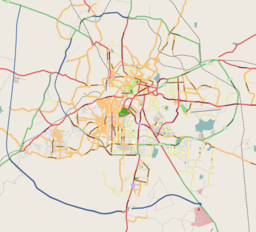Sankey tank
| Sankey Tank | |
|---|---|
 | |
| Location | Bangalore District, Karnataka |
| Coordinates | 13°01′N 77°34′E / 13.01°N 77.57°E |
| Lake type | Freshwater |
| Primary inflows | Rainfall |
| Catchment area | 1.254 km (0.8 mi) |
| Basin countries | India |
| Surface area | 15 ha (37.1 acres) |
| Max. depth | 9.26 m (30.4 ft) |
| Shore length1 | 1.7 km (1.1 mi) |
| Surface elevation | 929.8 m (3,050.5 ft) |
| Islands | 1 |
| Settlements | Bengaluru |
| 1 Shore length is not a well-defined measure. | |
Sankey tank (Kannada:ಸ್ಯಾಂಕಿ ಕೆರೆ), a manmade lake or tank, is situated in the western part of Bangalore in the middle of the suburbs of Malleshwaram, Vyalikaval and Sadashivanagar.[1] The lake covers an area of about 15 ha (37.1 acres). At its widest, the tank has a width of 800 m (2,624.7 ft)[2]
Sankey tank was constructed by Col. Richard Hieram Sankey (RE)[3] of the Madras Sappers Regiment, in 1882, to meet the water supply demands of Bangalore.[4] The tank was also known as Gandhadhakotikere, as the Government Sandalwood Depot used to be located near the lake.
History[edit | edit source]
Sankey reservoir was constructed in 1882. It was linked to the Miller's tank and Dharmambudhi tank and was built as a safeguard against water shortages, such as that experienced in the Great Famine of 1876–78. The quality of water was not very good and when Governor of Madras visited Bangalore on July 1888. A local wit commented, "The men who are thrown off their horses and killed on the spot at Bangalore are the only ones that are allowed by doctors not to have died from drinking bad water".[5]
Threats[edit | edit source]
The threats posed to the survival of the lake, which were also identified by the local people (morning joggers) using the lake, refer to:[6]
- Contamination of water with sewage flowing in from seven points, which are connected to storm water drains
- Choked drains with garbage and sewage
- Leaking sewage pipes connected to a public toilet at a park
- Decrease in the biological oxygen demand and high BOD content due to sewage
- Threats to fish and plants. During the tests conducted in 2001 also the DO was reported to vary from 3.7 to 8.1, BOD between 2 and 8 and the pH varied from 7.1 to 7.5.[7]
- Reduction number of ducks, fish and migratory birds due to polluted condition of the lake waters
Restoration actions[edit | edit source]
The tank was converted into a park by the Bangalore Water Supply and Sewerage Board (BWSSB) and the Bangalore Mahanagara Palike (BMP) with funds provided by the Government of Karnataka. In addition, the following were also implemented.[6]
- Removing encroachments
- Alum purification treatment to absorb toxic elements and germs
- Nursery towards the north.
- Paved Walkways
- Landscaped parks
- Special tank for idol immersion during Ganesh Chaturthi festival
- Restoration of swimming pool
Legal land encroachment tangle[edit | edit source]
In 2004, local builders’ proposal to construct a multistory building in the Sankey tank bed was challenged by petitioners in the Karnataka Lok Adalat (Peoples Court, an adjunct of the High Court). But the Court was informed by the Bangalore Mahanagar Palike (BMP) that it had not sanctioned any plan for the proposed building and that it would take immediate action to prevent any such steps by the developer taken without a no-objection certificate from the Ministry of Environment and Forests.[8]
The Lok Adalat ordered the Forest Department to repossess 0.52 ha (1.3 acres) of land belonging to it from the real estate developers who had set out to build an apartment block there. The Lake Development Authority also recommended that no construction or development activity should be allowed within a distance of 100 m (328.1 ft) from lakes in order to ensure that the water bodies in the city are not encroached and their conservation and protection are not stalled. The Karnataka State Pollution Control Board (KSPCB) informed the court that the proposal of Abhishek Builders and Mantri Developers to build an 18–floor luxury apartment block near the Sankey Tank has been turned down as gross violations were noted under the Air (Prevention and Control of Pollution) Act and the Water (Prevention and Control of Pollution) Act.[9]
See also[edit | edit source]
References[edit | edit source]
- ↑ "Sankey Tank, Bangalore".
- ↑ "The Hindu". Archived from the original on 4 May 2003. Retrieved 2 October 2006.
{{cite web}}: CS1 maint: unfit URL (link) - ↑ Reference for full name as per his work available online in the book Lang, A. M. (ed). 1878. Professional Papers on Indian Engineering. 2 Vols. Rourkee. Internet Archive Link
- ↑ Patrao, Michael (17 December 2013). "When parks were a lark". No. Bangalore. Deccan Herald. Retrieved 20 January 2015.
- ↑ Hasan, M Fazlul (1970) Bangalore through the centuries. Historical Publications. pp. 185-186
- ↑ 6.0 6.1 Sankey tank gets a new life
- ↑ Water Quality Monitoring of Lakes in and around Bangalore
- ↑ "Sights, sounds and smells from Bangalore". Deccan Herald News paper. Retrieved 7 December 2008.
- ↑ "Lok Adalat asks Forest Dept. to take back Mantri land". Hindu News paper. Retrieved 9 December 2008.


